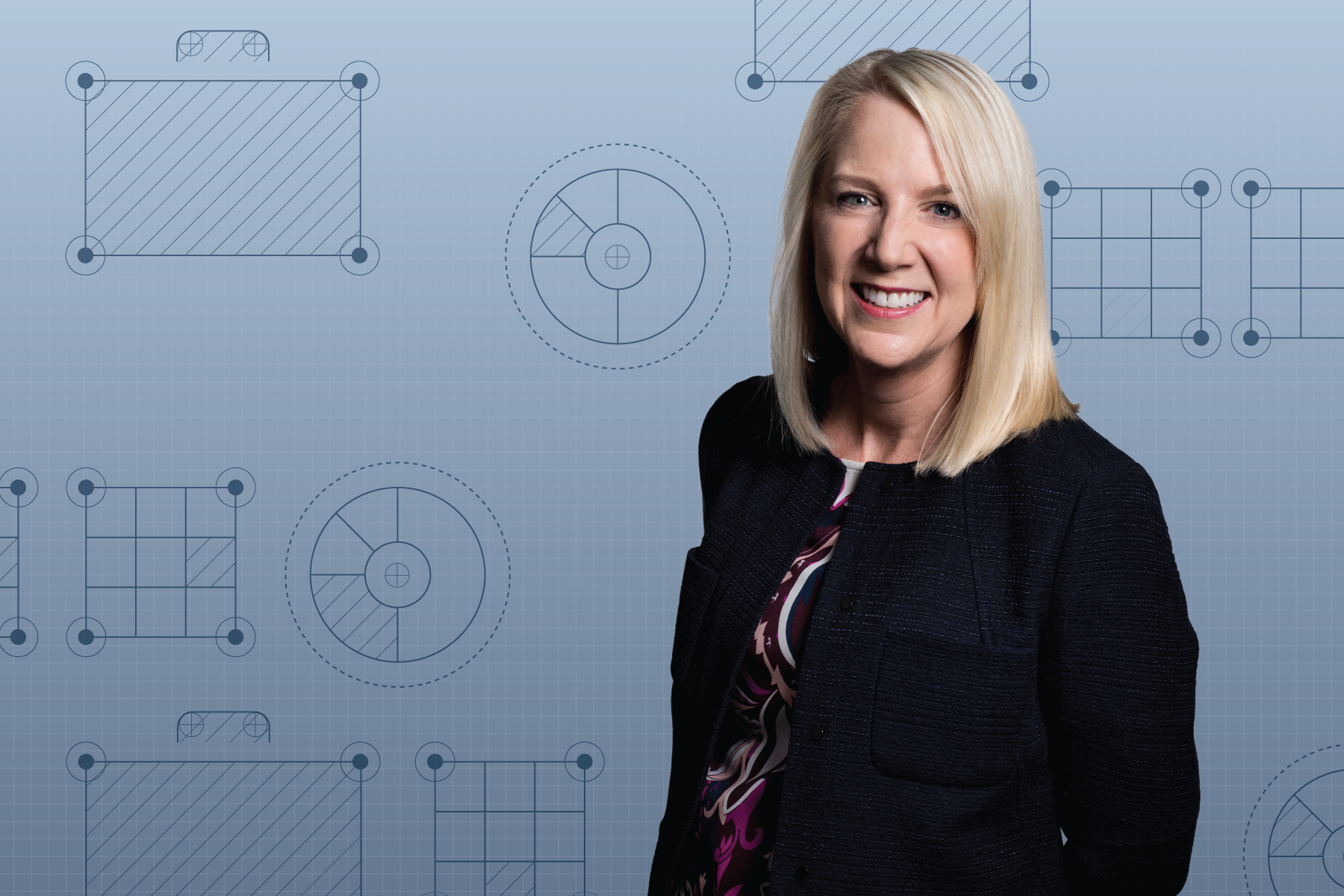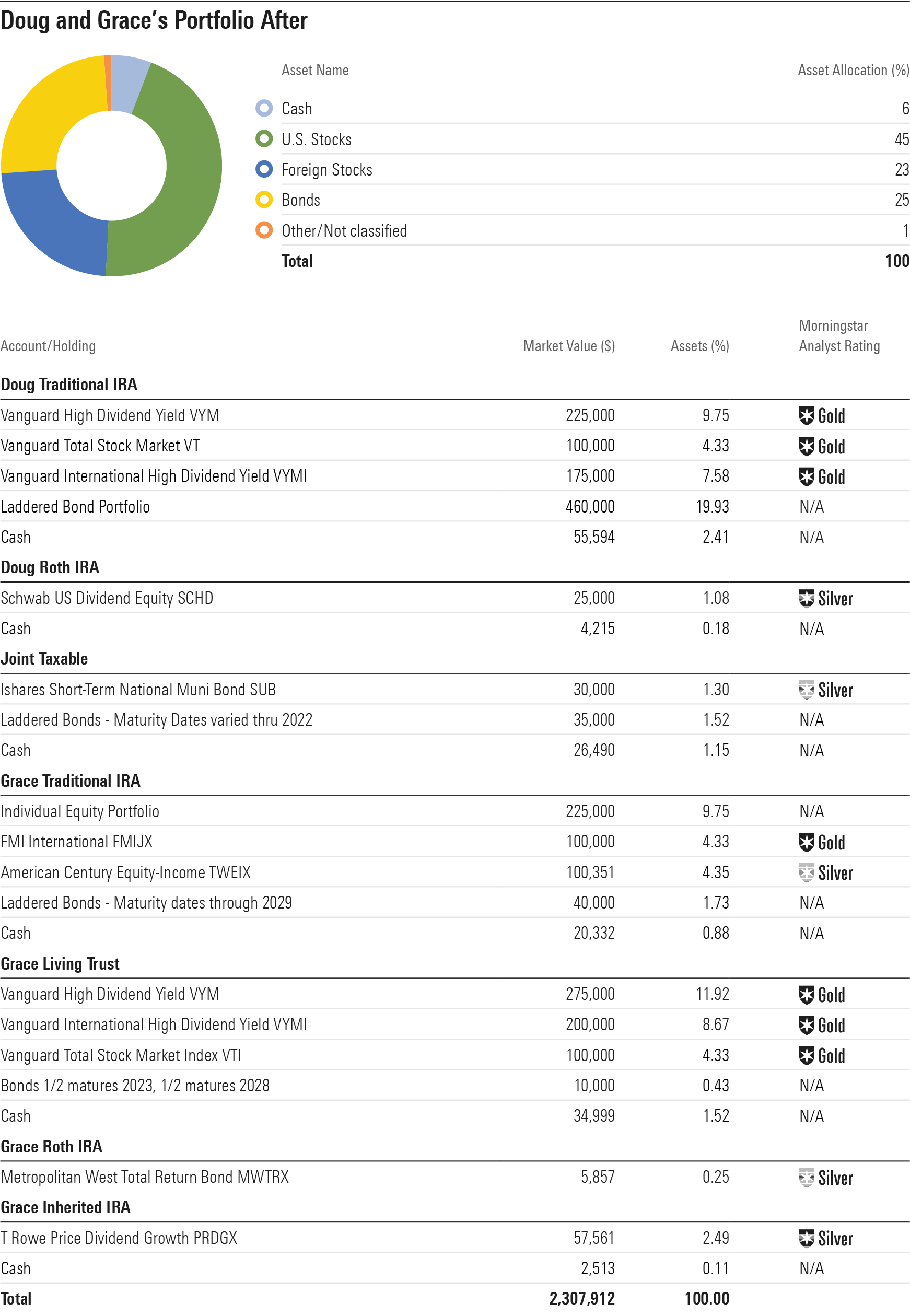Retired DIY Investor: Is It Time to Delegate?
This retiree loves following the market and investing in stocks, but would a simpler portfolio make more sense?

When is it time for a committed do-it-yourself investor to simplify and turn the reins over to someone else?
That’s a question weighing on the mind of Grace, a 66-year-old retired attorney. An avid stock investor, she actively oversees a $2.3 million portfolio for herself and her husband Doug, 71. Doug retired from his career in the pharmaceutical industry a year ago, and Grace has been retired for about five years. The couple has two children. Both are in their 30s and thriving in their careers; one is married and has two young children.
Grace truly enjoys stock investing. "I am the financial person in the household. I love to follow the market, tweak investments, and pounce on a good stock when it meets my targets," she said. The portfolio she oversees numbers more than 100 holdings, mainly individual dividend-paying stocks.
But she is also realistic about the fact that she may not be able to continue doing so indefinitely. "I am still of sound mind and body but am able to understand that this 'sound mind' won't last forever," she said.
Grace acknowledges that their unwieldy portfolio could create headaches for her and Doug down the line. "It's way too complicated for my husband, should he outlive me, and way too complicated for me to continue into my old age."
She knows that jettisoning all of the individual stocks in favor of a streamlined mutual fund or exchange-traded fund portfolio would achieve her goal of simplification. But even though their portfolio includes a few funds, Grace doesn't like to pay management fees. And if she stops overseeing their portfolio, she'll miss what has been a gratifying and engaging hobby. "While I can, I'd still like to follow stocks and keep my mind challenged."
Grace wrote seeking advice on how to balance those two sets of considerations: her love of investing her own money with her desire to ensure a smooth transition if she were unable to continue to manage their assets.
The Before Portfolio Because of Grace's interest in individual stock investing, the portfolio is quite equity-heavy given the couple's life stage. Roughly 70% of assets are in stocks and stock funds, with the remainder in cash and bonds. While the couple holds some actively managed mutual funds and ETFs, the bulk of those equity holdings are individual stocks--73 separate companies, to be exact.
Grace favors dividend payers, so nearly all of the couple's holdings have attractive yields relative to the broad market. The emphasis on yield gives the total portfolio a very strong bias toward value: 50% of the portfolio's equity exposure lands in the value column of the Morningstar Style Box. By contrast, total market index funds have roughly a third of their assets in value stocks. The emphasis on value and yield plays out in the portfolio's sector exposure, too: It’s heavy on financials, energy, industrials, real estate, and healthcare relative to the broad market, while it has limited exposure to the technology sector. In most important respects, it's as if Grace is running a dividend-focused mutual fund. In fact, the median actively managed large-value mutual fund has 73 stocks, too.
The largest account is Doug's traditional IRA, accounting for nearly one half of their assets. It includes numerous individual stocks, mainly large caps. The average Morningstar Rating, reflecting current valuation and Morningstar analysts' forward-looking view of a company's prospects, is 3 stars. Doug's IRA also holds nearly half of its assets in a laddered bond portfolio. In addition, he holds positions in mutual funds, including the excellent American Century Equity-Income TWEIX, and a cash component.
Doug also has a smaller Roth IRA, the result of having converted some of his traditional IRA assets to Roth last year. Grace says the couple plans to continue with the conversions annually for the foreseeable future, wisely converting just enough to remain in the same tax bracket. "We are now, in retirement, in lower tax brackets, and believe the current tax schedule is as good as it will ever get for us," she said.
Grace's own IRA has a similar complexion: It's invested in individual stocks, many of which overlap with those in Doug's portfolio, a laddered bond portfolio, a handful of mutual funds, and cash. She too has a small Roth IRA.
In addition, Grace has a living trust that she expects to leave to her children. Grace says that the trust is set up to provide Doug with income if she predeceases him. Like the couple's other major accounts, it is composed mainly of individual stocks.
Finally, the couple has a few smaller accounts: a taxable brokerage account consisting mainly of bonds and cash, as well as a small inherited IRA from Grace's parents.
Grace and Doug have done a lot of things right from a financial planning perspective. They have long-term care coverage, and they don't have any debt apart from a $280,000 mortgage on their home, which Grace estimates to be worth $750,000. Grace says they plan to pay it off with an inheritance they expect to receive upon Doug's mother's passing. They also own half of a lake house that Grace and her brother inherited from their parents. Grace estimates its value at $600,000.

Source: Morningstar.
The After Portfolio I agree with Grace's concern that their portfolio is too unwieldy to manage at this life stage. Thus, my After portfolio aims to radically streamline it while also providing an outlet for Grace's interest in investing.
My After portfolio relies on a basic bucket system: liquid reserves, bonds, and stocks. The asset allocation is roughly two thirds equities and the remainder in cash and bonds. The equity component includes significantly more non-U.S. stocks than in the Before portfolio--about a third of equity assets. That reduces the portfolio's home-country bias and also potentially adds to the portfolio's return potential over the next decade, as many market experts believe foreign stocks will outperform U.S. stocks. I retained Grace's emphasis on dividend-paying stocks but employed funds rather than individual stocks.
Because dividends from the equity portion of the portfolio will continue to supply a portion of their ongoing cash flow needs and because Grace and Doug's expenses will decline once their mortgage is paid off, buckets 1 and 2 are a bit smaller than would be the case in my standard bucket portfolios. They account for just seven years' of needed cash flows, as opposed to 10. To help facilitate tax management, allowing Grace and Doug to draw from the accounts while also keeping their tax bills down, I built liquidity into each of the accounts.
Vanguard High Dividend Yield VYM and Vanguard International High Dividend Yield VYMI were my go-tos for higher-yielding equity exposure in Doug's traditional IRA and in Grace's living trust as well. They provide similar exposure to the stock portfolio but they’re diversified, low-maintenance, and have very low price tags--0.06% and 0.27%, respectively. Each fund has a yield of nearly 3.5% as well. I also added a position in a total market index to provide exposure to sectors such as technology that they were light on.
While I didn't disrupt Grace and Doug’s bond ladders, my bias would be to invest into short- and intermediate-term core bond mutual funds as those bonds mature. Yes, mutual funds can lose money, especially in rising interest-rate environments. But I think that risk can be mitigated by matching the investor's time horizon with the right type of bond fund and not investing any near-term cash flow needs in bonds. And bond funds help simplify the portfolio, an especially valuable goal for retirees. As their bonds mature, I'd like to see them fold in some exposure to Treasury Inflation-Protected Securities in addition to nominal bonds in their IRAs. Alternatively, the couple could use fixed-maturity ETFs, such as Invesco BulletShares, in lieu of mutual funds.
To help satisfy Grace's interest in following the market and choosing stocks, I carved out a stake in her IRA for individual equity holdings. That subportfolio amounts to about 10% of the couple's overall portfolio. I also liked the equity mutual funds Grace had chosen, so retained most of them in her IRA but enlarged the positions.
The After portfolio focuses on liquidity and safety for the taxable account. It can be tapped with light tax consequences if the couple needs cash beyond what Social Security, Doug's pension, and Doug's required minimum distributions supply. I removed Treasuries and TIPS from this portion of the portfolio due to tax-efficiency considerations.

Source: Morningstar.
In addition to Grace and Doug's portfolio, I also took a close look at the viability of their plan. Grace noted that they're currently spending $185,000 to $200,000 per year. Roughly $90,000 of that cash flow need comes from Doug's pension and the couple's Social Security (Grace just filed), but the remaining $110,000 is coming from their portfolio--a 4.7% withdrawal rate, and an even higher withdrawal when you consider taxes and that a portion of their portfolio, Grace's living trust, is earmarked for their children. Grace notes that they wanted to pursue some big trips in the early years of retirement, which accounts for a portion of that sizable outlay. Their travel plans are on hold because of COVID-19, but they're undertaking some home renovations in the meantime.
Paying off their mortgage will reduce their portfolio withdrawals to a more comfortable level. In fact, one of my first thoughts when reading through Grace and Doug's situation was that they should pay off their mortgage as soon as possible rather than waiting for the inheritance. Even though mortgage rates are very low today, paying down a mortgage is an easy call for retirees who plan to stay in their homes and have the funds to do so. After all, the debt paydown reduces cash flow demands on the portfolio while also providing a higher guaranteed return on investment than they can earn on cash or even most bonds today. The problem is, Grace and Doug's money is largely siloed in tax-sheltered vehicles; withdrawing nearly $300,000 for debt paydown would result in a sizable tax bill. So waiting makes sense.
To help ensure continuity in their plan, it's a good idea for Grace and Doug to sit down with a financial planner in the near term. Plenty of worthy advisors will work on an hourly or per-project basis, which should help alleviate Grace's concerns about paying for advice on an ongoing basis. Establishing that relationship will ensure that Grace and Doug have another set of eyes on their retirement plan and will also provide a backstop if Grace is unable to continue to manage their financial plan and/or her basket of individual equities.
Editor’s note: Names and other potentially identifying details in portfolio makeovers have been changed to protect the investors’ privacy. Makeovers are not intended to be individualized investment advice, but rather to illustrate possible portfolio strategies for investors to consider in the full context of their own financial situations.
The author or authors do not own shares in any securities mentioned in this article. Find out about Morningstar’s editorial policies.

/s3.amazonaws.com/arc-authors/morningstar/66112c3a-1edc-4f2a-ad8e-317f22d64dd3.jpg)
/cloudfront-us-east-1.images.arcpublishing.com/morningstar/LUIUEVKYO2PKAIBSSAUSBVZXHI.png)
/cloudfront-us-east-1.images.arcpublishing.com/morningstar/HCVXKY35QNVZ4AHAWI2N4JWONA.png)
:quality(80)/s3.amazonaws.com/arc-authors/morningstar/66112c3a-1edc-4f2a-ad8e-317f22d64dd3.jpg)